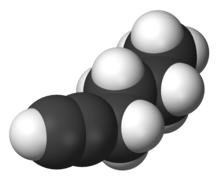This is the current revision of this page, as edited by Smokefoot (talk | contribs) at 20:02, 1 September 2023 (→Synthesis and reactions: n-butyl, not N-butyl). The present address (URL) is a permanent link to this version.
Revision as of 20:02, 1 September 2023 by Smokefoot (talk | contribs) (→Synthesis and reactions: n-butyl, not N-butyl)(diff) ← Previous revision | Latest revision (diff) | Newer revision → (diff)
| |

| |
| Names | |
|---|---|
| Preferred IUPAC name Hex-1-yne | |
| Other names n-Butylacetylene | |
| Identifiers | |
| CAS Number | |
| 3D model (JSmol) | |
| ChEBI | |
| ChemSpider | |
| ECHA InfoCard | 100.010.671 |
| EC Number |
|
| PubChem CID | |
| UNII | |
| CompTox Dashboard (EPA) | |
InChI
| |
SMILES
| |
| Properties | |
| Chemical formula | C6H10 |
| Molar mass | 82.146 g·mol |
| Appearance | colorless liquid (impure samples can appear yellowish) |
| Density | 0.72 g/cm |
| Melting point | −132 °C (−206 °F; 141 K) |
| Boiling point | 71 to 72 °C (160 to 162 °F; 344 to 345 K) |
| Solubility in water | 0.36 g/L |
| Hazards | |
| Occupational safety and health (OHS/OSH): | |
| Main hazards | Irritant, Flammable, Health Hazard |
| GHS labelling: | |
| Pictograms |   
|
| Signal word | Danger |
| Hazard statements | H225, H304, H315, H319, H335 |
| Precautionary statements | P210, P233, P240, P241, P242, P243, P261, P264, P271, P280, P301+P310, P302+P352, P303+P361+P353, P304+P340, P305+P351+P338, P312, P321, P331, P332+P313, P337+P313, P362, P370+P378, P403+P233, P403+P235, P405, P501 |
| Flash point | −20 °C (−4 °F; 253 K) |
| Except where otherwise noted, data are given for materials in their standard state (at 25 °C , 100 kPa).
| |
1-Hexyne is a hydrocarbon consisting of a straight six-carbon chain having a terminal alkyne. Its molecular formula is HC2C4H9. A colorless liquid, it is one of three isomers of hexyne. It is used as a reagent in organic synthesis.
Synthesis and reactions
1-Hexyne can be prepared by the reaction of monosodium acetylide with butyl bromide:
- NaC2H + BrC4H9 → HC2C4H9 + NaBr
Its reactivity illustrates the behavior of terminal alkylacetylenes. The hexyl derivative is common test substrate because it is conveniently volatile. It undergoes deprotonation at C-3 and C-1 with butyl lithium:
- HC2C4H9 + 2 BuLi → LiC2CH(Li)C3H7 + 2 BuH
This reaction allows alkylation at the 3-position.
Catechol borane adds to 1-hexyne to give the 1-hexenyl borane.
1-Hexyne reacts with diethyl fumarate to produce n-hexylsuccinic acid.
See also
References
- ^ Kenneth N. Campbell, Barbara K. Campbell (1950). "n-Butylacetylene". Organic Syntheses. 30: 15. doi:10.15227/orgsyn.030.0015.
- A. J. Quillinan, F. Scheinmann (1978). "3-Alkyl-1-Alkynes Synthesis: 3-Ethyl-1-Hexyne". Organic Syntheses. 58: 1. doi:10.15227/orgsyn.058.0001.
- Norio Miyaura Akira Suzuki (1990). "Palladium-Catalyzed Reaction of 1-Alkenylboronates with Vinylic Halides: (1Z,3E)-1-Phenyl-1,3-Octadiene". Organic Syntheses. 68: 130. doi:10.15227/orgsyn.068.0130.
- Hogsed, M. J.; Lindsey, R. V. (1953-10-01). "The Reaction of 1-Hexyne and Diethyl Fumarate". Journal of the American Chemical Society. 75 (19): 4846–4847. doi:10.1021/ja01115a517. ISSN 0002-7863.